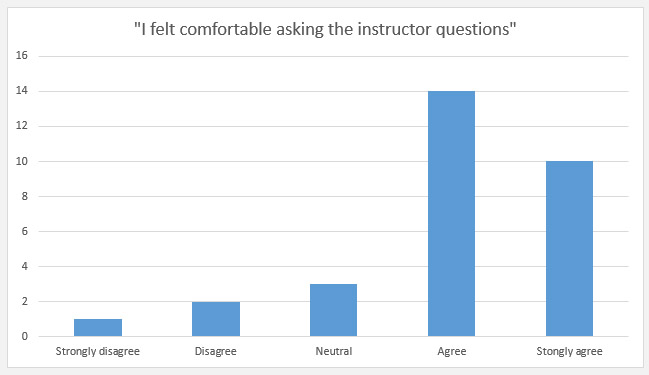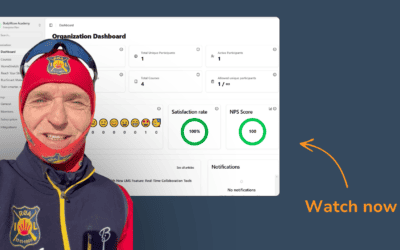Course Evaluations: How Do You Interpret Them Correctly?

Holding courses without asking your participants for course evaluations is a bit like driving a car without a steering wheel.
Course evaluations are directive for both the instructor’s work in and out of the classroom, as well as for the course business as a whole.
However, the amount of valuable information you get from the evaluations requires that you know how to read, organize and interpret the responses you have collected. In addition, you also need to know how to use these interpretations to improve your course offers.
Therefore, today I thought I would share my 8 best tips on how you can do just that.
You can’t make diamonds appear out of thin air
Before you can sit down and take a deep dive into the data you have collected, there are two things that should be in place:
1. Good course evaluation forms
First: Good interpretations start with the evaluation form itself. The best course evaluation forms contain few, well-formulated questions that have been carefully selected. Only when the right questions are in place will you get good answers that you can interpret and use to further develop your courses.
| “Effective interpretation starts with the survey itself.” @gigigriffis |
So, how do you select the right questions for evaluating your course?
The possibilities are many, but I recommend you to read my latest blog post with 5 tips on how to make good evaluation forms. Using these tips will leave you with a good starting point when interpreting the feedback you have received.
2. Get rid of the paper format
Furthermore, there is one more thing that will lay the foundation for how easy it is for you to interpret the results of the evaluations you have collected.
Despite the many good solutions for collecting course evaluations, many make it more difficult for themselves by handing out course evaluation forms on paper.
As a result, they get large amounts of extra manual work. In fact, using forms on paper makes it difficult to get anything sensible out of the course evaluations.
Today, there are endless providers of online surveys that you can use. There are even specialised Training Management systems that allow you to obtain course evaluations in the same systems in which you administer your courses. This way, you get all the answers in one place, connected to the specific course and to the specific participant. You can even easily compare how different instructors have been rated.
|
Are you afraid of low response rate when using electronic course evaluation? Here are two tips for you: 1. Have the participants take the evaluation on their own mobile or PC in the classroom before leaving the course. 2. If the participant has to pass an electronic test in order to pass the course, you can easily guide the participants through an electronic evaluation form before they can take the test. In this way, you make the course evaluation compulsory. |
How to interpret course evaluations
Since you now have secured good data through well-designed forms and navigated away from the paper size, the time has come to interpret the data you have collected.
Look at the right value
How you interpret the answers to your respondents, of course, depends on what questions you have asked. Still, there are some values to consider when analyzing the answers to your closed questions.
|
Open questions: Questions that provide a narrative answer. This means that the question cannot be answered with single words like “yes” or “no”. The respondent must fill in the answer himself. Closed questions: Closed questions are the opposite to open questions. With a closed question, the respondent simply cannot give any answer they wish. |
First: Make sure you don’t go into “average trap”, where you only evaluate what the average of a data set. There are large variations in the data past the average figures. Also: The average also doesn’t tell you whether your participants agree or disagree.
In addition to averaging, it may also be relevant (depending on the question) to take a look at the following values:
Standard deviation
Definition: A measure of the spread of the values in a dataset
What it can tell you: If the standard deviation is low, there is little spread. That means your participants pretty much agree. Is the standard deviation is large, the spread is larger and the respondents strongly disagree.
Median
Definition: The median is “in the middle of the table” if the results are set in descending (or ascending) order.
What it can tell you: The median is stable to extreme observations, which means it will not be affected by very dissatisfied and very satisfied participants to the same degree as the average. In other words, it will give a better indication of which opinion is most common.
Mode questions
Definition: The value of a number material that is “most typical”, ie the number that occurs most times.
What it can tell you: The mode tells you which opinion is “most typical” of your participants.
While all of this can easily be figured out in Excel and other data interpretation programs, I will include links to how you can calculate the different values:
- How to find the median in a dataset
- How to find the standard deviation in a dataset
- How to find the average in a dataset
- How to find mode in a dataset
By exploring the different values that your dataset gives you, you will form a more complete picture of what kind of experience your participants have gained from the course they have attended.
How to interpret open questions
Open questions give your participants the opportunity to formulate their answers on their own. While this can give you a deeper insight into what each participant is thinking, analyzing the results of these questions can be tricky.
But don’t worry: There are methods for this too.
One of the most common ways of analyzing open questions is to create word clouds. This is a visual representation of the most commonly used words and phrases in your responses. They often look like this:
The largest words are the words that have been mentioned most times. Such a presentation can help you understand how your participants talk about you and your courses, what challenges and needs they have, etc. With this knowledge, it will be easier for you to mirror the language and communicate effectively with your participants
Create visuals
Studies show that our brains process graphics 60,000 times faster than text. This means that both you and those you are potentially presenting your data to will have a better understanding if you make visual representations of your data.
Word clouds, as we have already mentioned, are a smart way to visually present answers to open-ended questions. For closed questions, you can use graphs, pie charts, etc.
How to deal with negative feedback
So, how do you actually deal with negative feedback?
First and foremost, it is important to remember that it is not possible to for evert participant to be 100% satisfied at all times.
No matter how well-delivered your courses are, there will always be a certain proportion of your participants who love the instructor and the course they have been on. While another proportion will be less satisfied with the experience they have had. This is partially because people have different preferences when it comes to learning methods and personal traits of the instructor.
In other words, you should not be influenced by one of the more extreme opinions. However if you are, there is a high probability that you are constantly being pulled in two different directions and is unsure of what you should actually do differently.
If you see that there is a large proportion of participants on each end of the spectrum, this means that you hit the jackpot with many participants. However you completely miss the needs of another proportion of your participants. For example if this is the case when your participants evaluate the instructor’s learning method, you may want to offer a wider range of learning methods, or possibly offer the same course tailored to your different target groups.
For instance, if you receive large amounts of mediocre reviews, this may be a sign that you are delivering perfectly OK, but should do more to impress. A new round of course evaluations will tell you what it takes to do just that.
This brings us to the next point.
Interpret the data with your goals in mind
Everything you do should be based on the goals, strategy and plan your business has for the courses you offer. It includes course evaluations. When choosing questions for the evaluation form, collecting the forms, interpreting the results and updating old forms, you should always keep this in mind.
Let’s take an example. You are already offering a course in Google Analytics for beginners and are planning to create a new advanced course. The goal is to get participants who have already been to an initial course to come back to a course for advanced students.
With this in mind, you do not just select generic questions about the first course your participants have attended. You are also looking for information such as:
- How did they discover the course they just attended?
- Was the first course so good that they would like to take more courses with you?
- What other courses is this group of participants interested in?
- What would they like to learn about an advanced course?
This information will help you design the new course best for your target audience, make you better able to reach them and update your evaluation form.
Course evaluations: Not the only source of information
With well-designed forms, effective solutions for gathering course evaluations, good analytics, and great presentation of your data, it may feel like you have a good foundation for making decisions.
And while course evaluations are an important part of the foundation you should use to improve your course offers, this should not be the only basis.
Why? Well, because …
- People don’t always know what they like or want.
- What works for past participants may not work for your future participants.
- Not all of your participants submit an evaluation.
- People are not always honest.
- People can think of answering random answers to get the evaluation completed as quickly as possible.
So what do you do to get as good and complete a picture as possible? You use multiple sources. Perform an annual reassessment of the relevance of all courses you offer, reflect and share experience with others inside and outside your business, look at relevant studies and literature, jot down ad hoc feedback (which you received via email and through chat in the classroom ) and social media feedback.
Only by using multiple sources of information will you get a holistic picture that is suitable as the basis for your future decisions.
Get more out of your course evaluations today
Have you already picked up a bunch of course evaluations? Then you have a gold mine in front of you that you should start analyzing today.
If you have not yet started obtaining evaluations, you can easily create, collect and get an overview of all the company’s course evaluations in FrontCore’s course management system . Read more about Course evaluations in FrontCore here.
Good luck!
- 117 sample questions in different categories
- How to achieve high response rate
- How to get high quality feedback
- How to effectively collect evaluations
Did you like this article? Don't forget to share it:

About FrontCore
Over 3700 training providers use solutions from FrontCore – and that’s not without reason. FrontCore is one of Norway’s leading competence environments within cloud based systems for Training Management, Learning Management and Webmarketing. With over 23 years of experience from the training industry and our finger on the market pulse continuously, we help course and training providers achieve more efficiency and higher revenue.
Get your tasks done with Checklist Template for Courses
Products

Related articles
Guide: How to start a training business
Thinking of starting your own training company in the UK? Get all the essential steps, insights, and expert tips in this complete guide—plus how the right tools can help you succeed from day one. Ready to launch your training business?
Kirkpatrick model: How to use it in your training business
Curious about how to measure your training’s true impact? Discover how the Kirkpatrick Model can help you improve your courses, boost participant satisfaction, and achieve real business results.
A new version of our LMS is here: More flexible, engaging, and smarter than ever
Upgrade your LMS experience with a smarter, more flexible platform. Discover a new course editor, AI-powered tools, embedded quizzes, and smarter dashboards that enhance learning and engagement. Ready to transform your e-learning?










0 Comments